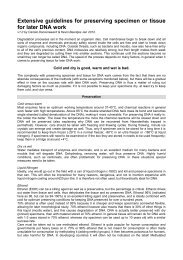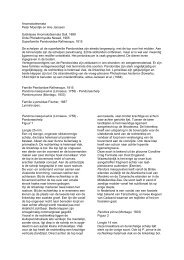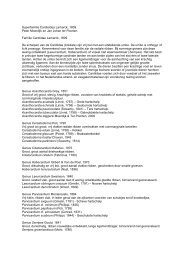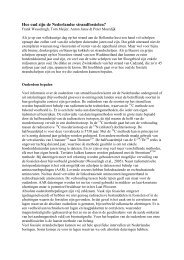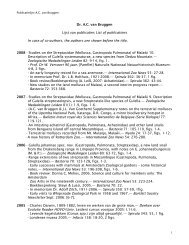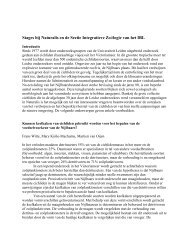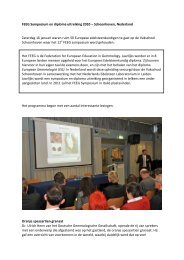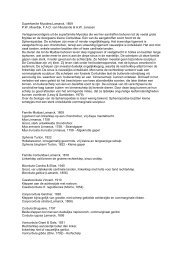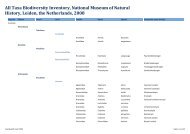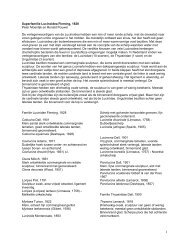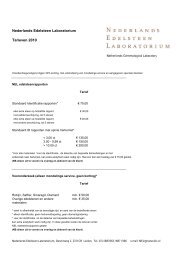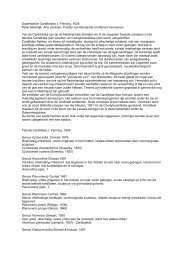The Odonata of Sulawesi and adjacent islands ... - science . naturalis
The Odonata of Sulawesi and adjacent islands ... - science . naturalis
The Odonata of Sulawesi and adjacent islands ... - science . naturalis
Create successful ePaper yourself
Turn your PDF publications into a flip-book with our unique Google optimized e-Paper software.
Libellago <strong>and</strong> Sclerocypha <strong>of</strong> <strong>Sulawesi</strong><br />
Abdomen: S1-5 dorsally mainly orange-red, remaining segments dark-red; S1 dorsally<br />
with brownish black semicircular marking in anterior half; S2-5 with faint dark<br />
longitudinal stripe next to middorsal line, somewhat darker against hind margin <strong>of</strong><br />
each segment; ventral side <strong>of</strong> S1, anterior half <strong>of</strong> S2 <strong>and</strong> S9-10 black, <strong>and</strong> weak dark<br />
markings on ventral side <strong>of</strong> other segments; sternites brownish black. Appendages<br />
matt-black.<br />
Measurements [mm]: Abdomen 19; Hw 25.<br />
Description <strong>of</strong> female<br />
Coloration remarkably different from male, <strong>and</strong> yellowish white markings similar to<br />
other <strong>Sulawesi</strong> species.<br />
Head: Labium with middle <strong>and</strong> lateral lobes with extensive pale markings at base;<br />
m<strong>and</strong>ibles <strong>and</strong> genae also whitish, clypeus black, frons with a paired marking nearly<br />
completely covering it, extending onto the vertex; scapus also pale yellowish white.<br />
Thorax: Prothorax similar to male, but posterior lobe with two triangular lateral<br />
markings, rather than a posterior stripe along hind margin; synthorax mesepisternum<br />
with distinct pale stripe, covering anteriorly ca ⅔ the height <strong>of</strong> mesepisternum, but<br />
strongly tapering posterior to posterior corner <strong>of</strong> mesokatepisternum, mesepimeron<br />
black, metepisternum with large pale stripe, starting well anterior to metastigma,<br />
posterior to stigma rectangular, posteriorly with black transverse stripe, <strong>and</strong> continued<br />
in crescent-shaped marking covering ca length <strong>of</strong> metepisternum; pale marking<br />
almost completely covering metepimeron, leaving only a narrow black dorsal<br />
margin.<br />
Abdomen: Narrow medio-dorsal pale line on S2-7, a wider lateral stripe, covering<br />
S1-8, with a spot on S9, line interrupted on annulae, but pale marking extending<br />
further antero-ventrally, <strong>and</strong> even along margin <strong>of</strong> tergites on S3-8.<br />
Measurements [mm]: Abdomen 18, Hw 25; without significant variation.<br />
Variation<br />
Male specimens from Gimpu lack the thin median longitudinal marking, projected<br />
from the broad transverse b<strong>and</strong> on the posterior lobe <strong>of</strong> the pronotum (Fig. 3b),<br />
which is present in specimens from Tanah Mateh. Specimens from Tonusu near Lake<br />
Poso (leg. A. Günther) are intermediate between the nominotypical subspecies <strong>and</strong><br />
L. c. orientalis ssp. nov, but specimens show significant variation, especially in the<br />
coloration <strong>of</strong> head <strong>and</strong> the pale markings on the posterior lobe <strong>of</strong> the pronotum.<br />
Measurements [mm]: Abdomen <strong>of</strong> males 19-21; Hw 25-27.<br />
Distribution<br />
Palu valley, <strong>and</strong> possibly the Lariang valley, i.e. the area now covered by the western<br />
part <strong>of</strong> the Lore Lindu National Park, between 400 <strong>and</strong> 600 m a.s.l. (Fig. 6). <strong>The</strong>re<br />
are no records from the northeastern side <strong>of</strong> the Lore Lindu National Park, where<br />
Sclerocypha bisignata inhabits areas above ca 800 m a.s.l. <strong>The</strong> latter species is also<br />
common at higher altitudes south <strong>of</strong> Lake Poso, where L. c. anoa <strong>and</strong> L. c. dorsonigra<br />
inhabit the rivers between 0 <strong>and</strong> 600 m. Populations in streams around Lake<br />
Poso need further study.<br />
International Journal <strong>of</strong> Odonatology 10 (2) 2007: 209-248, pls II, III<br />
223



